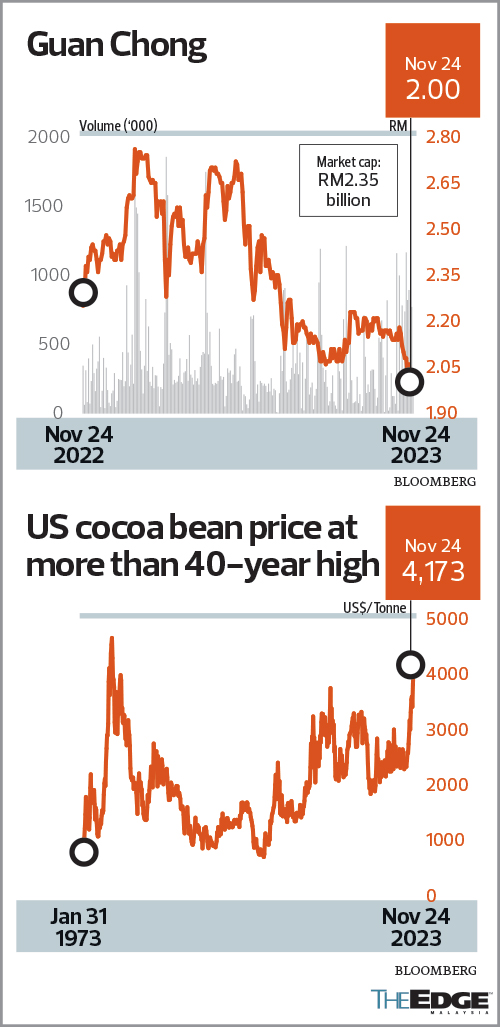
This article first appeared in The Edge Malaysia Weekly on November 27, 2023 - December 3, 2023
SINCE peaking at RM3.70 in August 2020, shares in cocoa grinder Guan Chong Bhd have been heading south, in tandem with the surge in cocoa bean prices to the highest levels seen in more than 40 years, driven mainly by the tight supply of cocoa beans and the El Niño weather.
Last week, as cocoa futures breached US$4,000 a tonne again, having soared 60% year to date, Guan Chong’s share price reacted by tumbling to a more than three-year low of RM1.99.
Given that cocoa bean prices are unlikely to ease significantly in the near term, analysts say the world’s fourth-largest cocoa grinder may not be able to see a quick improvement in its financial performance.
“High cocoa bean prices will affect demand for grinding capacity in the future, not in the short term. That is one part of the uncertainty faced,” an analyst who declined to be named tells The Edge.
“If this is followed by a drop in market demand, then Guan Chong’s [shares] will be under pressure as well,” he adds.
From a mid-term view, he opines that Guan Chong is undervalued given its established operations and sales channels. “But when cocoa bean prices stabilise, we should see a more normalised operating environment.”
Nonetheless, investors adopting a short-term view may continue to shy away from Guan Chong’s shares.
“Right now, we haven’t even factored higher cocoa bean prices into our forecasts … If you have a short-term investment horizon, it looks like there is more uncertainty. But once cocoa bean prices take a turn, coupled with stable market demand, then it will be a very good future for them. Contribution from the Ivory Coast facility should also kick in, and all these are catalysts for the stock,” the analyst explains.
The analyst also notes that Guan Chong’s forward-selling mechanism remains robust.
“Basically, they deliver based on their scheduled dates; the only moving part in the short term is the mark-to-market losses coming from the derivatives because of the high cocoa bean prices.
“Although Guan Chong can sell higher in order to pass on the costs, there’s a limit to the prices chocolate manufacturers can pay. It may dampen consumer demand if chocolate prices are too high, thus affecting grinding margins,” he says.
He observes that because of the price issue, global chocolate manufacturers are adopting a wait-and-see attitude, hoping for relief.
Inter-Pacific Securities analyst Chai Jia Yue believes Guan Chong could remain under pressure from skyrocketing cocoa bean prices on the back of the delayed harvest arising from unpredictable weather patterns and swollen shoot disease.
Its combined ratio is suppressed as the average selling prices of cocoa butter and powder still lag cocoa bean prices.
While Guan Chong’s valuations look a bit more attractive at this point, she cautions that the operating environment may still be “quite challenging”.
She has a “neutral” call on the counter with a target price of RM2.34.
Bloomberg data shows that of the three research houses covering the stock, only RHB Research has a “buy” call on the stock and the highest target price of RM3.11. Meanwhile, there are two “hold” calls with a consensus target price of RM2.64, implying an upside potential of 32% based on its closing price of RM2 last Friday. At its current price, Guan Chong is valued at RM2.35 billion.
For the first six months of 2023 (1HFY2023), Guan Chong’s net profit halved to RM51.88 million from RM97.88 million in the same period a year ago due to reduced sales volume and higher finance costs.
In FY2022 and FY2021, its net earnings came in at RM148.95 million and RM154.84 million respectively.
Commenting on its outlook, Guan Chong has said it will maintain its focus on its core business of cocoa ingredient processing, as well as the expansion of the higher-margin industrial chocolate market and optimisation of production according to market conditions.
Its newly commissioned UK facility has boosted the group’s annual industrial chocolate capacity by 16% or 16,000 tonnes to 116,000 tonnes.
In total, Guan Chong has a total annual grinding capacity of 377,000 tonnes, with major production facilities located in Pasir Gudang, Johor (150,000 tonnes), Batam, Indonesia (120,000 tonnes) as well as San Pedro, Ivory Coast (60,000 tonnes). Its cocoa ingredients are exported to more than 70 countries, including chocolate manufacturers and other leading cocoa ingredient traders.
Bloomberg estimates show that Guan Chong may still post a better net profit of RM156.7 million in FY2023, followed by RM202.3 million in FY2024 and RM265 million in FY2025.
Rakuten Trade expects Guan Chong’s core net earnings to stay flat at RM127.9 million for FY2023, before improving to RM183.1 million in FY2024.
It, however, is cautious about the group’s financial leverage as its net gearing has reached almost 0.9 times with an interest coverage ratio of 2.1 times.
“According to the management, more than two-thirds of the borrowings are in US dollars or other foreign currencies, which act as a natural hedge against US dollar receivables and inventory,” the research house says in an Oct 6 note.
Though Guan Chong does not have a fixed dividend policy, Rakuten Trade expects it to pay dividends of 2.7 sen and 3.9 sen for FY2023 and FY2024 based on a 25% payout ratio. This will translate into dividend yields of 1.2% and 1.8% respectively.
As at end-June 2023, Guan Chong was in a net debt position of RM1.58 billion, with RM1.64 billion in gross borrowings.
The company’s shares are tightly held by the founding Tay family via Guan Chong Resources Sdn Bhd, with a 49.78% stake. Another substantial shareholder is the Employees Provident Fund, which holds 5.54% equity interest.
Save by subscribing to us for your print and/or digital copy.
P/S: The Edge is also available on Apple's App Store and Android's Google Play.

